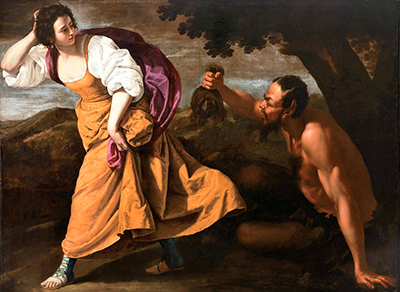Artemisia Gentileschi's painting (The Nymph) Corisca and the Satyr is a depiction of a scene from the fable play of The Faithful Shepherd (Il Pastor Fido). First penned in the 1580s by poet Giovanni Battista Guarini.
This 1630s Baroque painting relative to the play, signifies the artist's inner turmoil and revival. Corisca and the Satyr is currently held in a private collection in Italy. The oil painting is a bold departure from common Biblical scenes of this period by Artemisia's Old Master renaissance counterparts. However it's very on point subjectively. One of many Caravagesques, a keen demonstration in the style of the great Italian painter Caravaggio.
The mainstay of Gentileschi's greatest works is femininity overcoming men. Due to her own experience of rape by mentor Tassi. 300 years before Women's Suffrage, here was a female artist evoking stronger individual female characteristics via a plateau of mesmerising colour and descriptive Baroque style stances - in an industry dominated by males.
The scene from Il Pastor Fido (Act II Scene VI) depicts a Satyr, a horse eared Greek mythological spirit that has a permanently enlarged phallus. A character which has a heightened sexual need while lacking the morals of a Gentleman. Corisca on the other hand was a Nymph, also a nature spirit, that used her prowess to deviously lead men on. The scene shows a clump of the Nymph's hair held by the Satyr. This has meaning. While the female's appearance has been shattered, she still escapes with her dignity. Speaking more of Gentileschi's personal experience.
Artemisia was clearly drawn to the well received fable. The play by Guarini was first requested to be completed for the wedding of Leonora de' Medici. A family known to her father and whom she also did commissions for in London. Upon moving to Naples she studied Lanfranco and Domenichino. To embed in the locality successfully she took to changing her style of painting for the Neapolitan circle. This saw the use of characters that were more refined against a larger more detailed backdrop rather than the central foreground usage to date.
For some time Corisca and the Satyr (Corsica e Il Satiro) was attributed to Massimo Stanzione. Until the signature of Old Master Artemisia Gentileschi was found in the corner on the tree. The baroque oil painting is no small feat. It measures 155 cm by 210 cm and is of her desired style. Blues and golds which is rumoured to have been grasped due to her relationship with Michelangelo Junior, a descendant of the great.
For those new to discovering Artemisia Gentileschi, Corisca and the Satyr will be a revelation and a tilt to female empowerment. Though the well recorded incident of rape should not detract from her subjects of interest, it is essential to take in the story while appreciating the artistic ventures of facial emotion. The relative opaque obvious junctures between characters featured and the oil technique as applied to canvas.




